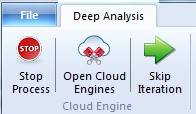Most chess players analyse their games interactively. They try out variations on the board and let them be evaluated by chess engines.
This is very good for preliminary analysis so that you can get used to the motives of the position, but sometimes engines need more time to examine a position in detail. For this it is necessary to let an engine examine a position for a long time.
Board window: Analysis - Deep Analysis
![]()
In the deep analysis the engine generates a tree with the possible moves.
The analysis is left to run by itself. The longer it runs, the more reliable the variations are. After longer times the search depth is bigger, but not too complex so that the result remains easy to understand. Variations that do not look good after a large search depth are automatically removed. This leads to an annotation with an analysis of the most important moves. This function is an improvement over Fritz's deep position analysis, because no time is specified and the variation tree is dynamically restructured as the search progresses. After the function has been started the program calculates indefinitely and generates an analysis tree with the best moves and replies. The tree is dynamically updated and weaker variations are removed.
The program analyses candidate moves and makes the moves for further analysis, as every chess player would do it himself. This generates a tree which changes from iteration to iteration. Every iteration increases the processor time.
In the notation variations are shown in grey if they do not seem good at the current depth. If a variation cannot be proved to be good at two consecutive depths it disappears from the notation, so that only the best continuations are analysed and displayed.
During the analysis there are two ways you can influence the analysis:

Stop Process: This halts the analysis. The result can be stored as a different game, or the existing notation can be overwritten.
Open Cloud Engines: You can add cloud engines to the analysis to improve the quality. The function then accesses engines that are running in parallel.
One engine makes the candidate moves and creates a variation tree. In the example this is done by Fritz 13.
The additional cloud engines calculate answers to the moves simultaneously, which are then added without losing any time. In the example this is done by the Houdini engine.
The title bar of the engine window tells us what function the engine has.
The candidate engine runs in multi-variation mode, because it has to calculate a lot of candidate moves.
During the deep analysis other engines can be added to the cloud server without interrupting the analysis. These engines automatically adopt the correct roles. If individual cloud engines stop running the analysis continues, as long as at least one local engine is running.
Skip Iteration: This skips an analysis level, which increases the processor time and the analysis depth of the engine.
Note: Variations that are in the notation at the start of the analysis are never deleted and are always analysed, unless they are the results of a previous Cloud Analysis.
Moves that have been marked with a question mark are never analysed.